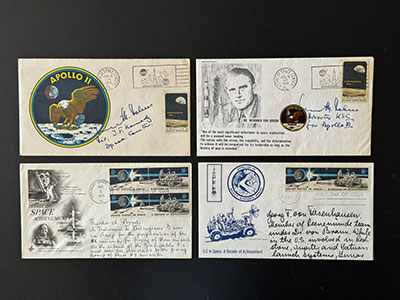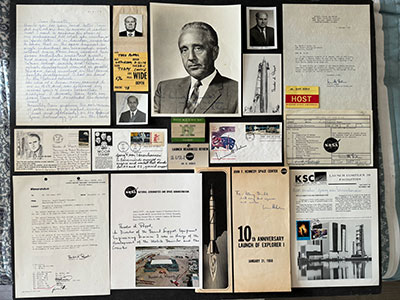Ken Havekotte
Member Posts: 3812
From: Merritt Island, Florida, Brevard
Registered: Mar 2001
|
 posted 05-04-2024 03:54 PM
posted 05-04-2024 03:54 PM
   
This is my second Space Autograph Spotlight, which will feature a trio of space pioneer autograph material representing a story of a dream that has become a reality. More specific information about each of the spotlighted trio of key rocket pioneer leaders selected for this particular feature may be added in a later post if there is more interest from the cS community.Those men were Dr. Kurt H. Debus (1908-1983), then directing the new NASA launch team stationed at the Marshall Space Flight Center (MSFC) in Huntsville, Alabama, along with team members Theodor A. Poppel (1927-2002) and Georg F. von Tiesenhausen (1914-2018) of NASA at Huntsville. All three by 1961 had spent 25 years in rocket development, first with the creation of the German war-time A4 (V-2) ballistic missile at Peenemunde and later with the U.S. Army at the White Sands Missile Range in New Mexico, at Redstone Arsenal in Huntsville, Alabama, along with the new Marshall space center established in 1960.  Newly elected U.S. President John F. Kennedy had been in office only 16 days since January 20, 1961 when the three men met to discuss the establishment of a free-world spaceport in central Florida for launching heavy space vehicles. The first request was for a 200- square-mile area north and west of existing Cape Canaveral launch pads. A Launch Operations Center (LOC) would be established as an independent NASA field center, to be know as the Merritt Island Launch Area (MILA), for a civilian (non-military) space flight launch complex that would take men to the moon in the years to come. Dr. Debus asked colleagues Poppel and von Tiesenhausen to study new launch concepts for large rockets of between 5,000,000 and 10,000,000 pounds of liftoff thrust. On March 21, 1961, Debus brought another German/U.S. colleague of theirs, Albert Zeiler, into the initial planning phase. He appointed Zeiler chairman of a group to consider new concepts for the assembly, checkout, and launch of large rocket vehicles. One of the reasons of the study was to provide pre-launch operations in an area removed from launch zone hazards. Nine days later, just within a week before the Soviet Union put the first man into space, Debus appeared before the MSFC's Management Board and outlined his team's concepts. Two weeks passed during which the newly established NASA since July 1958 formulated proposals for President Kennedy that were designed to achieve leadership for the nation in this new frontier of peaceful space exploration.  The plans were approved by senior NASA officials at our nation's capital, first, with the building and construction of the first unmanned Saturn/Apollo rocket ship launch pad complexes. In addition, plans were signed off with conducting feasible studies for a launch base that would become world famous Launch Complex 39, from which American astronauts would depart for the moon. Debus returned from Washington, D.C. and called Poppel, von Tisenhausen, and Zeiler (along with a few others that had been contacted that same month) and set the machinery in motion to create the first free-world's operational spaceport, known today as NASA's John F. Kennedy Space Center located on a barrier island (Merritt Island) in Florida. The signed material depicted here is a tribute to those three outstanding and visionary German/U.S. rocket engineers and planners that had devoted most of their lives in getting America into space and on the moon. Their names will forever be associated with the early history of Spaceport USA. Note: Albert Zeiler may be included in a future spotlight posting along with a few others from this early phase. |
Bob M
Member Posts: 1905
From: Atlanta-area, GA USA
Registered: Aug 2000
|
 posted 05-07-2024 03:25 PM
posted 05-07-2024 03:25 PM
   
Very informative and interesting post, Ken, about three significant rocket pioneers from Peenemunde and impressive material from them. Like you, I spent a lot of time contacting members of von Braun's original 118-member team and we both ended up with a nice collection of autographs from these rocket scientists who played important parts in America's military and civilian space programs, but who earlier were involved in the design and testing of the infamous V-2 rockets used mainly against civilians in England in WWII.The top cover marks von Braun's death in 1977 and is signed by Kurt Debus (Kennedy Space Center director), Arthur Rudolph (Saturn V manager at Marshall Space Flight Center) and Eberhard Rees (MSFC director). The bottom cover (note that the stamp pictures a captured V-2 rocket launch) is signed by Theodor Poppel, plus five more members of von Braun's team of rocket scientists.  |














